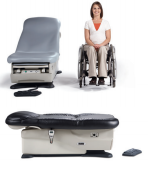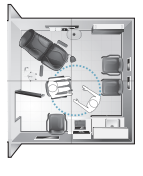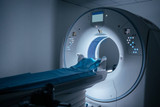ABCs of the Accessible Exam Room Requirements
TL;DR: ADA-compliant exam rooms are essential for equal care. Key elements include accessible entrances, height-adjustable tables, and clear floor space. Accessible design improves safety, efficiency, and patient satisfaction.
- ADA Standards
Ensure equal access, prevent injuries, reduce legal risk, and boost patient satisfaction. - Entry & Access Routes
- Hallways and doorways must be wide, clear, and unobstructed.
- Door width: at least 32" wide when open.
- Barrier-Free Exam Equipment
- Height-adjustable tables (17"–19")
- Removable rails, support surfaces, and wide-platform scales
- Clear Floor Space
- Minimum 30"x48" for transfers
- 60"x60" turning space for wheelchairs or portable lifts
Following accessible exam room requirements is about more than just compliance.
Every patient, regardless of physical ability, deserves the same standard of care in a safe, respectful environment. Yet, for individuals who use wheelchairs, walkers, or other mobility devices, navigating a traditional doctor’s office exam room can be a frustrating or even impossible experience. That’s where accessible exam room design comes in.
Accessible exam rooms have features that make it possible for all patients, including those who are disabled and/or use mobility devices, to receive equal medical care.

ADA Standards for Accessible Design in Healthcare
Under the ADA Standards for Accessible Design, all patients should be able to enter the exam room, move around the room, and utilize the equipment provided. These standards were put in place to break down barriers that prevent individuals with disabilities from receiving the same quality of care as everyone else.
By adhering to ADA standards:
- Patients receive equal care: Height-adjustable exam tables and sufficient turning space allow patients with disabilities to undergo exams and procedures just like any other patient.
- Facilities minimize risk: Noncompliance can result in injuries during transfers, missed or incorrect diagnoses, and even legal consequences.
- Healthcare teams work more efficiently: Accessible exam room layouts and equipment reduce the physical strain on caregivers and prevent delays caused by having to improvise during patient transfers or repositioning.
- Patient satisfaction improves: Individuals feel more respected and valued when they can move through a hospital exam room confidently and comfortably.
All exam rooms must follow the standards set by the ADA. Learn more about the medical exam room requirements and consider how your facility measures up.

Accessible Routes and Entryways
Make sure every access point—from the front entrance to patient intake—meets the accessible exam room requirements outlined by ADA and other regulatory bodies. This ensures both your patients and staff can safely enter and move through your facility.
- Accessible hallways to the exam room and other common-use areas
- Entry door has a 32" minimum width when the door is open to 90 degrees
- Hallways outside of the room and the area inside the doorway are free of obstacles such as boxes, chairs, and tables
Barrier-Free® Exam Table and Scales
Modern medical exam room requirements include height-adjustable tables, adaptable seating, and scales that accommodate various body sizes and assistive devices. Consider investing in bariatric equipment as well, since these products can make patient care more accessible.
- Exam surface lowers between 17" to 19" above the floor, or wheelchair height, so there is no need to step up to access the exam table
- Removable/adjustable support rails
- Articulating exam surface for support during patient transfers and positioning
- Exam surface extensions, such as head and foot rests, for additional support and positioning options
- Accessible scale with a platform large enough to fit a wheelchair and a high weight capacity, or a scale integrated into a patient lift, hospital bed or exam table

Clear Floor Space
- A minimum of 30" x 48" of clear floor space around the exam table for patient entry, exit, and transfer, or to accommodate a portable lift device
- Space for an individual using a wheelchair to make a 180-degree turn, using a clear space of 60" in diameter or 60" x 60"
This is an important consideration to ensure caregivers and patients can move freely during procedures. In compliance with standard exam room size recommendations, it’s vital to avoid cluttering this zone with storage furniture or mobile carts.
For more information about ADA guidelines, visit the ADA website at ada.gov or call the ADA Information Line toll-free at 800-514-0301 (voice) or 800-514-0383 (TTY). Information courtesy of Midmark Corporation.
Exam Room Layouts that Prioritize Accessibility
In addition to individual room features, overall exam room layouts play a vital role in accommodating patients with disabilities. Designing a functional hospital exam room means accounting for space not only around the exam table but also near the other essential work areas, like the sink. Layouts should allow enough room for the patient to independently move or be assisted without creating a bottleneck or discomfort.
Your clinical workflow should also align with accessibility. For instance, have at least one accessible exam room per specialty. Also, consider providing visual and auditory alerts for patients with sensory impairments and making sure signage meets ADA readability standards.
Start Creating a Standardized Approach to Accessibility
Healthcare facilities must consistently assess how well each exam room aligns with accessible exam room requirements. They should also look beyond treatment spaces to make sure waiting rooms and other common areas are accessible.
If you’re looking to create a more efficient, accessible facility, Exam Tables Direct is here to help. Browse our complete collection of examination room furniture and medical equipment that can help improve compliance and your daily workflow.
Recent Posts
-
Medical Device Industry: 7 Trends to Watch for Your Practice
TL;DR: The medical device industry is evolving rapidly, transforming how healthcare professionals de …29th Dec 2025 -
The Difference Between 224 and 225 Midmark Power Tables
When it comes time to purchase a new exam chair for your practice, you’ll have many options and bran …11th Dec 2025 -
Compliance Matters: Meeting Medical Equipment Standards
TL;DR: Understanding and maintaining medical device compliance is vital for ensuring patient safety, …27th Nov 2025



